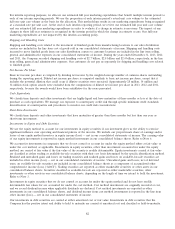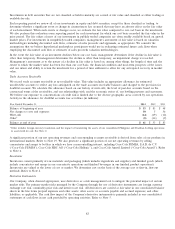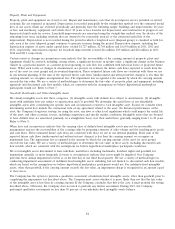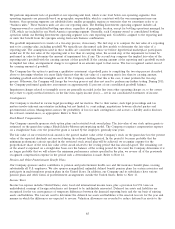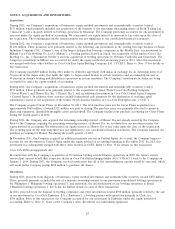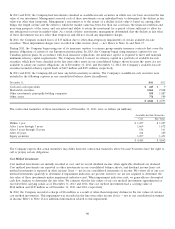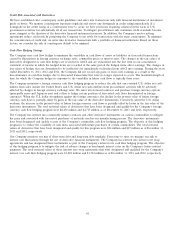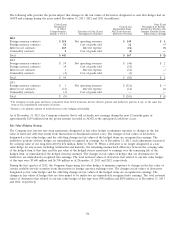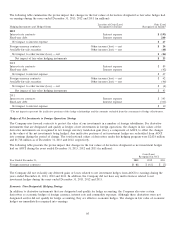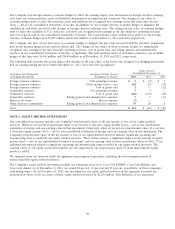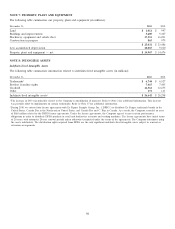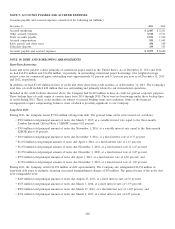Coca Cola 2013 Annual Report Download - page 92
Download and view the complete annual report
Please find page 92 of the 2013 Coca Cola annual report below. You can navigate through the pages in the report by either clicking on the pages listed below, or by using the keyword search tool below to find specific information within the annual report.
In 2013 and 2012, the Company had investments classified as available-for-sale securities in which our cost basis exceeded the fair
value of our investment. Management assessed each of these investments on an individual basis to determine if the decline in fair
value was other than temporary. Management’s assessment as to the nature of a decline in fair value is based on, among other
things, the length of time and the extent to which the market value has been less than our cost basis; the financial condition and
near-term prospects of the issuer; and our intent and ability to retain the investment for a period of time sufficient to allow for
any anticipated recovery in market value. As a result of these assessments, management determined that the decline in fair value
of these investments was not other than temporary and did not record any impairment charges.
In 2011, the Company realized losses of $17 million due to other-than-temporary impairments of certain available-for-sale
securities. These impairment charges were recorded in other income (loss) — net. Refer to Note 16 and Note 17.
During 2011, the Company began using one of its insurance captives to reinsure group annuity insurance contracts that cover the
pension obligations of certain of our European pension plans. In 2013, the Company began using insurance captives for our
Canadian pension plans. In accordance with local insurance regulations, our insurance captive is required to meet and maintain
minimum solvency capital requirements. The Company elected to invest its solvency capital in a portfolio of available-for-sale
securities, which have been classified in the line item other assets in our consolidated balance sheets because the assets are not
available to satisfy our current obligations. As of December 31, 2013, and December 31, 2012, the Company’s available-for-sale
securities included solvency capital funds of $667 million and $451 million, respectively.
In 2013 and 2012, the Company did not have any held-to-maturity securities. The Company’s available-for-sale securities were
included in the following captions in our consolidated balance sheets (in millions):
December 31, 2013 2012
Cash and cash equivalents $ 245 $9
Marketable securities 2,861 2,908
Other investments, principally bottling companies 958 1,087
Other assets 778 589
$ 4,842 $ 4,593
The contractual maturities of these investments as of December 31, 2013, were as follows (in millions):
Available-for-Sale Securities
Cost Fair Value
Within 1 year $ 1,227 $ 1,227
After 1 year through 5 years 1,669 1,672
After 5 years through 10 years 156 161
After 10 years 336 329
Equity securities 1,097 1,453
$ 4,485 $ 4,842
The Company expects that actual maturities may differ from the contractual maturities above because borrowers have the right to
call or prepay certain obligations.
Cost Method Investments
Cost method investments are initially recorded at cost, and we record dividend income when applicable dividends are declared.
Cost method investments are reported as other investments in our consolidated balance sheets, and dividend income from cost
method investments is reported in other income (loss) — net in our consolidated statements of income. We review all of our cost
method investments quarterly to determine if impairment indicators are present; however, we are not required to determine the
fair value of these investments unless impairment indicators exist. When impairment indicators exist, we generally use discounted
cash flow analyses to determine the fair value. We estimate that the fair values of our cost method investments approximated or
exceeded their carrying values as of December 31, 2013 and 2012. Our cost method investments had a carrying value of
$162 million and $145 million as of December 31, 2013 and 2012, respectively.
In 2012, the Company recorded a charge of $16 million as a result of other-than-temporary declines in the fair values of certain
cost method investments. This impairment was recorded in the line item other income (loss) — net in our consolidated statement
of income. Refer to Note 16 for additional information related to this impairment.
90




